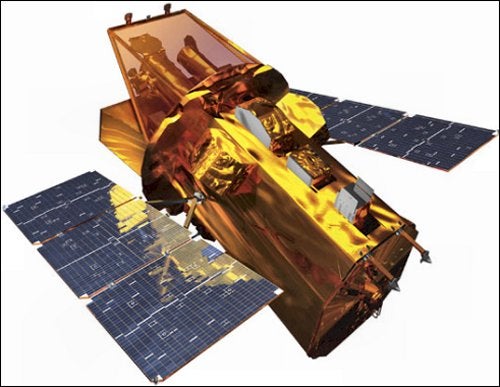For the first time, a gamma ray burst (GRB) was imaged during its explosive act. An orbiting satellite named Swift accomplished this feat. A product of a NASA-led international collaboration launched November 20, 2004, Swift is designed to study the mysterious, powerful GRBs — the most explosive events in the universe since the Big Bang. On January 17, days before even being fully operational, two of Swift’s three instruments successfully detected and imaged GRB050117.
According to Neil Gehrels, Swift’s principal investigator at NASA’s Goddard Space Flight Center in Greenbelt, Maryland, the image is the first “prompt X-ray emission from a gamma ray (burst), and Swift’s first autonomous slew caught in the act.”
Within an hour after the BAT detected the burst, its location was transmitted to ground-based stations for further analysis. Four hours later, four observatories were searching for GRB050117’s optical and infrared emissions. For future detections, telescopes in orbit will join ground-based observatories and turn to the burst location to observe the afterglow and its surrounding region — dramatically increasing the amount of data captured.
Penn State University’s David Burrows, the XRT team leader, said processing data from GRB050117 will take about 2 weeks — so neither an image of the burst nor conclusive results is available at this time. Project scientists think it likely the burst resulted in a new black hole.
Swift response
Swift locates and images the source of GRBs faster than any previous instrument. Most bursts last less than 10 seconds and few last 1 minute — so immediate response is critical for learning more about these mysterious phenomena.
Burrows emphasized the significance of quick detection and analysis: “Getting to the bursts before they fade gives us a chance to gather more clues to the burst’s origin. The longer look gives us more light to look at and a bigger spectrum” to analyze.
In fact, project scientists wear beepers to alert them any time of day — when a GRB is detected.
According to Burrows, Swift data provides a time capsule from the first generation of star formation. Swift can peer deeper into the universe — farther back in time — than any previous instrument.
No optical image available
Swift’s third instrument, the UltraViolet/Optical Telescope (UVOT) was not yet operational to capture its own image of GRB050117.
Burrows says all the instruments will be operational days ahead of the scheduled February 1 goal.
On January 24, all three instruments completed gathering data from another burst, GRB050124. Not automated at the time, Swift focused its instruments on the burst 3 hours after its explosion. Each instrument executed its responsibilities successfully.










